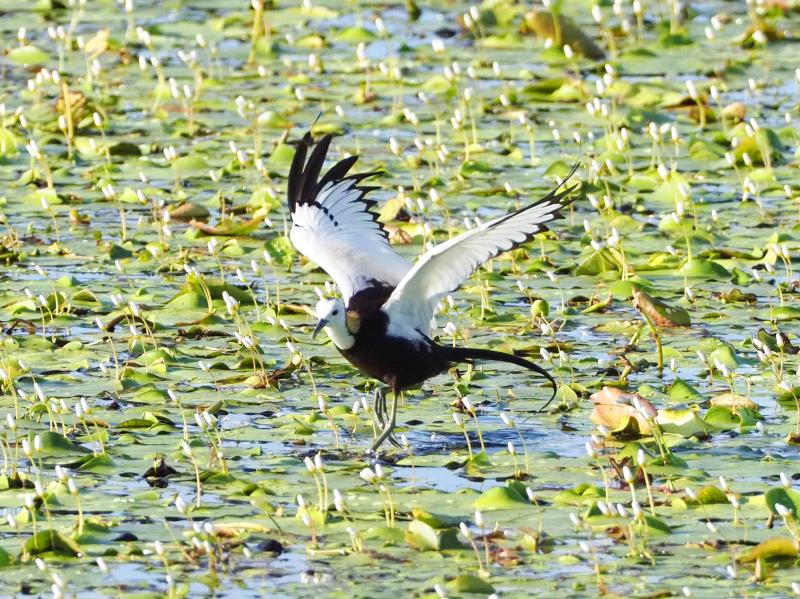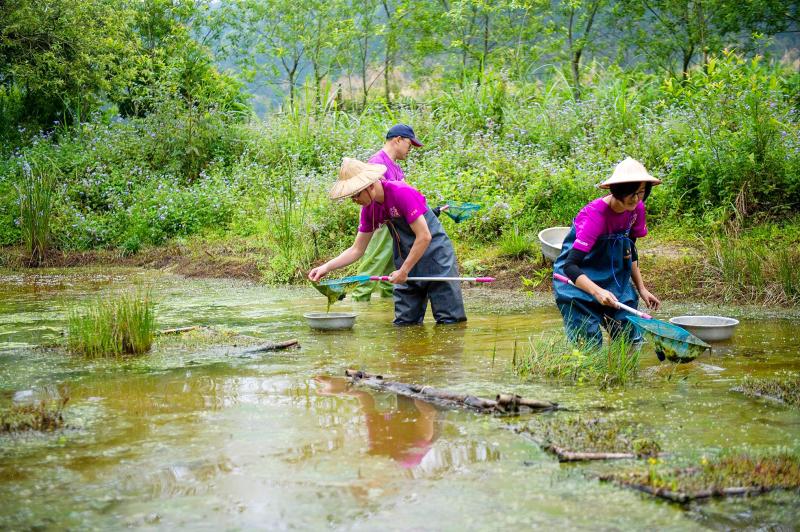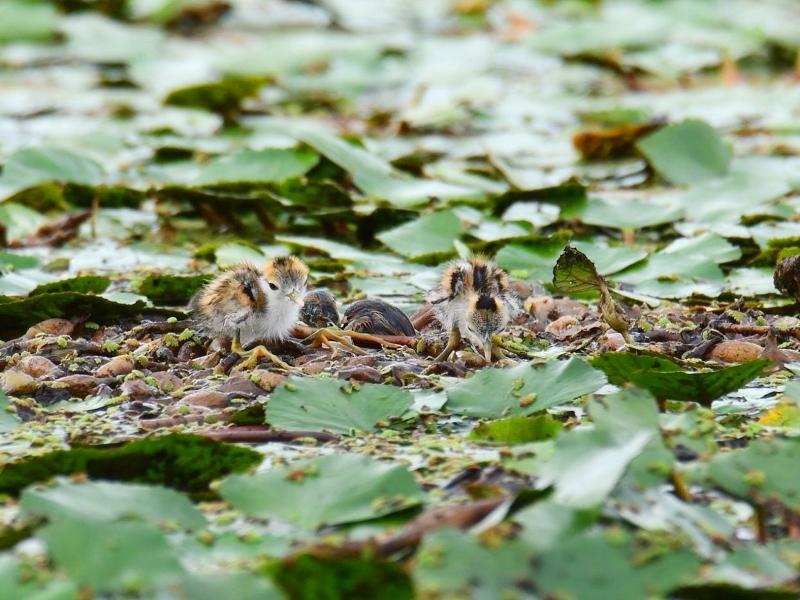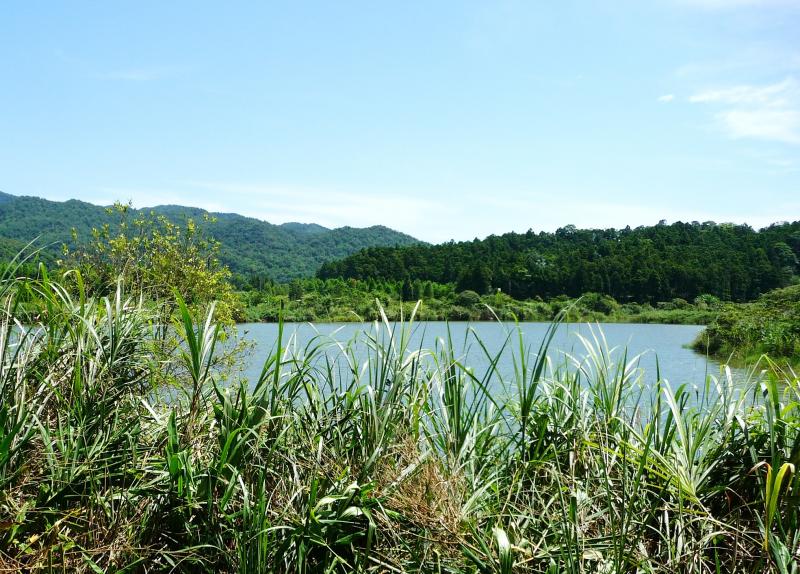Writing about environmental issues can be dispiriting, but the outlook isn’t entirely bleak. Here in Taiwan, in recent decades, public attitudes to the environment have certainly changed for the better — even if citizens’ daily behavior doesn’t always reflect the priorities they express in opinion surveys.
In this country as elsewhere, non-governmental organizations (NGOs) make it easier for concerned citizens to support and participate in conservation work. Nonprofits have played a key role in several successful environmental projects, including the two profiled below.
SOCIETY OF WILDERNESS AND SHUANGLIANPI

Photo courtesy of Meinong Lake Jacana Conservation Area Volunteers
Protection of habitats and natural ecosystems is a core objective of Society Of Wilderness (SOW, 荒野保護協會, www.sow.org.tw), a Taipei-headquartered NGO.
At 80 locations around Taiwan, volunteers from its 11 local chapters take part in ecological survey and monitoring work, habitat preservation, species restoration, the removal of invasive species and environmental education.
“The largest and most successful case we’ve been involved in is Shuanglianpi (雙連埤) in Yilan, a wetland in a low-elevation mountainous area,” says SOW Secretary-General Lua Jane-lung (劉建隆).

Photo courtesy of Society of Wilderness
Agricultural development throughout the 20th century several damaged the area’s ecosystems, Lua explains. However, SOW successfully lobbied the local and national governments to bring the site under the protection of laws such as the Wetland Conservation Act (濕地保育法). In 2003, 17.16 hectares of dry land and water, around 480m above sea level in Yuanshan Township (員山), was designated Shuanglianpi Wildlife Refuge (雙連埤野生動物保護區).
The central government provided NT$53 million for the purchase of privately-owned land, to ensure that the source of the wetland’s water is under government control.
According to the Forestry Bureau’s Web site, the goal of the wildlife refuge is to sustainably preserve the genetic biodiversity of the wetland and its surrounding Machilus-Castanopsis sub-montane evergreen broadleaved forest.

Photo courtesy of Meinong Lake Jacana Conservation Area Volunteers
Depopulation makes this task easier. Since the 1980s, many of the descendants of those who worked hard to convert the wilderness around Shuanlianpi into productive farmland have relocated to the lowlands. What used to be an elementary school campus, closed down in 1993 due to a lack of school-age children, served for a while as SOW’s ecological classroom.
At least a third of Taiwan’s aquatic plant species can be found within the refuge. Among the 112 types of aquatic plant identified here are Salix kusanoi (水社柳, an endemic willow species), Trapa incisa var. Sieb. (野菱, a type of herb) and watershield (蓴菜等, Brasenia schreberi).
Certain rare aquatic plants that disappeared from Shuanglianpi due to human interference have been successfully reintroduced, thanks to the joint efforts of SOW and the Wistron Foundation (the charitable arm of electronics manufacturer Wistron Corp), Lua says.

Photo: Steven Crook
The grassy habitat surrounding the water is an ideal breeding ground for aquatic insects. There have been recorded sightings of 58 dragonfly species, 32 species of other aquatic insects and 206 species of terrestrial insects.
Among amphibian creatures often spotted at Shuanglianpi are Bufo bankorensis, (盤古蟾蜍) an endemic toad and Zhangixalus prasinatus (翡翠樹蛙, sometimes called the emerald green treefrog). In addition to being found nowhere in the world except for northern Taiwan, the latter is the country’s largest tree frog. As you’d expect in a place where an abundance of insects keeps its frogs and toads well fed, there are also snakes.
Conservation efforts at Shuanglianpi don’t exclude human history.
Stone cottages built by Hakka pioneers, such as the Zou Family Ancient Abode (鄒家古厝), are being preserved.
The hand-dug ditches that once irrigated fields near the wetland, and which fell into disrepair as people moved away, are being restored. In 2019, the Forestry Bureau commissioned the Environmental Ethics Foundation of Taiwan (人禾環境倫理發展基金會) to interview local elders, so traditional techniques could be relearned, and to deploy local manpower to restore these channels.
BIRD ENTHUSIASTS CREATE A NEW HOME FOR THE JACANA
Humans have destroyed countless habitats. They’ve also created some, more often by accident than by design.
Over the past five years, thanks largely to the efforts of Huang Shu-mei (黃淑玫) and her husband, Liu Hsiao-shen (劉孝伸), Meinong Lake (美濃湖) has become a breeding ground for a waterbird species that nests at just a handful of sites in Taiwan.
In 2017, Huang and Liu signed a lease on a one-hectare plot of land beside the lake, which is 40km northeast of downtown Kaohsiung. With the help of friends and volunteers, they began removing invasive plants and introducing aquatic plant species likely to attract the Pheasant-tailed jacana (Hydrophasianus chirurgus).
The jacana is an exceptionally alluring bird, and Huang hoped that, if the site became known as one of its breeding grounds, its presence would inspire visitors to take an interest in birds and, by extension, the habitat’s butterflies, dragonflies and plants.
“Before 2017, many Pheasant-tailed jacanas would spend the winter in Meinong, but they’d leave in the spring and nest elsewhere,” Huang says.
A major cash crop in the area is white water snowflake (野蓮, Nymphoides hydrophylla). Farmers who cultivate this vegetable don’t use a lot of agrochemicals, so there’s always an abundance of insects on which the jacanas can feed, Huang says.
To create an environment suitable for nesting jacanas, Huang obtained specimens of water caltrop (菱角, Trapa bicornis), Euryale ferox (芡實, prickly waterlily) and Nymphaea lotus (齒葉睡蓮, white Egyptian lotus). These were purchased or donated from Guantian (官田) in Tainan and from two locations in Kaohsiung, Kaotan (拷潭) and Weiwuying Metropolitan Parks (衛武營都會公園).
As far as bird enthusiasts are concerned, Guantian is synonymous with the Pheasant-tailed jacana. By the 1990s, this species was fast disappearing from Taiwan, even though it remained common in Southeast Asia. It looked as if Taiwan’s jacanas would make a last stand in the water-caltrop fields of Guantian — but an outpouring of concern, backed by practical measures such as the creation of the Jacana Ecological Education Park (水雉生態教育園區) in Guantian, reversed their decline.
The Meinong Lake project has been a success: Each year, jacanas nest and raise chicks in the new habitat. However, Huang says, it’s faced a number of challenges, among them rising costs, unfavorable weather and fluctuating water levels.
“We paid NT$50,000 rent for the first year. By the third year, however, the landlord was asking for NT$120,000,” says the retired teacher.
This increase is a consequence of farmers seeking plots where white water snowflake can be grown, she explains.
Realizing that the project was becoming too expensive to continue financing it by themselves, in 2020 Huang and Liu formalized a group of 69 supporters who pitched in a total of NT$465,000. Around the same time, Kaohsiung Wild Bird Society (KWBS) took over the site’s management.
Last year’s severe drought killed off many aquatic plants. Later, torrential rains killed some of the newborn jacanas.
Because Meinong Lake stores water for irrigation and acts as a flood-detention basin during the rainy season, Huang accepts that the water level will often deviate from what’s ideal for the jacana habitat.
In the early days, some locals complained that the fences erected around the jacana habitat to keep out cats and dogs were unsightly. But now that the plants and trees added to the site have matured, they’re more likely to compliment its appearance, Huang says.
Recognizing that what’s officially called Meinong Lake Jacana Conservation Area (美濃湖水雉棲地) is likely to draw more visitors to the area, Kaohsiung City Government Tourism Bureau is backing KWBS’s effort to develop a second jacana-friendly habitat next to the lake.
KWBS is also in charge of an aquatic-plant seedlings pond and a habitat workstation. The NGO has helped educate farmers that the jacanas eat insects which might otherwise harm their crops. Farmer patrol groups that check on nesting sites each month are subsidized by the Forestry Bureau.
Individuals, NGOs, and government units don’t always mesh. But Meinong Lake’s jacana project shows what can be achieved when stakeholders all pull in the same direction.
Steven Crook, the author or co-author of four books about Taiwan, has been following environmental issues since he arrived in the country in 1991. He drives a hybrid and carries his own chopsticks. The views expressed here are his own.

This month the government ordered a one-year block of Xiaohongshu (小紅書) or Rednote, a Chinese social media platform with more than 3 million users in Taiwan. The government pointed to widespread fraud activity on the platform, along with cybersecurity failures. Officials said that they had reached out to the company and asked it to change. However, they received no response. The pro-China parties, the Chinese Nationalist Party (KMT) and Taiwan People’s Party (TPP), immediately swung into action, denouncing the ban as an attack on free speech. This “free speech” claim was then echoed by the People’s Republic of China (PRC),

Exceptions to the rule are sometimes revealing. For a brief few years, there was an emerging ideological split between the Democratic Progressive Party (DPP) and Chinese Nationalist Party (KMT) that appeared to be pushing the DPP in a direction that would be considered more liberal, and the KMT more conservative. In the previous column, “The KMT-DPP’s bureaucrat-led developmental state” (Dec. 11, page 12), we examined how Taiwan’s democratic system developed, and how both the two main parties largely accepted a similar consensus on how Taiwan should be run domestically and did not split along the left-right lines more familiar in

Many people in Taiwan first learned about universal basic income (UBI) — the idea that the government should provide regular, no-strings-attached payments to each citizen — in 2019. While seeking the Democratic nomination for the 2020 US presidential election, Andrew Yang, a politician of Taiwanese descent, said that, if elected, he’d institute a UBI of US$1,000 per month to “get the economic boot off of people’s throats, allowing them to lift their heads up, breathe, and get excited for the future.” His campaign petered out, but the concept of UBI hasn’t gone away. Throughout the industrialized world, there are fears that

Most heroes are remembered for the battles they fought. Taiwan’s Black Bat Squadron is remembered for flying into Chinese airspace 838 times between 1953 and 1967, and for the 148 men whose sacrifice bought the intelligence that kept Taiwan secure. Two-thirds of the squadron died carrying out missions most people wouldn’t learn about for another 40 years. The squadron lost 15 aircraft and 148 crew members over those 14 years, making it the deadliest unit in Taiwan’s military history by casualty rate. They flew at night, often at low altitudes, straight into some of the most heavily defended airspace in Asia.